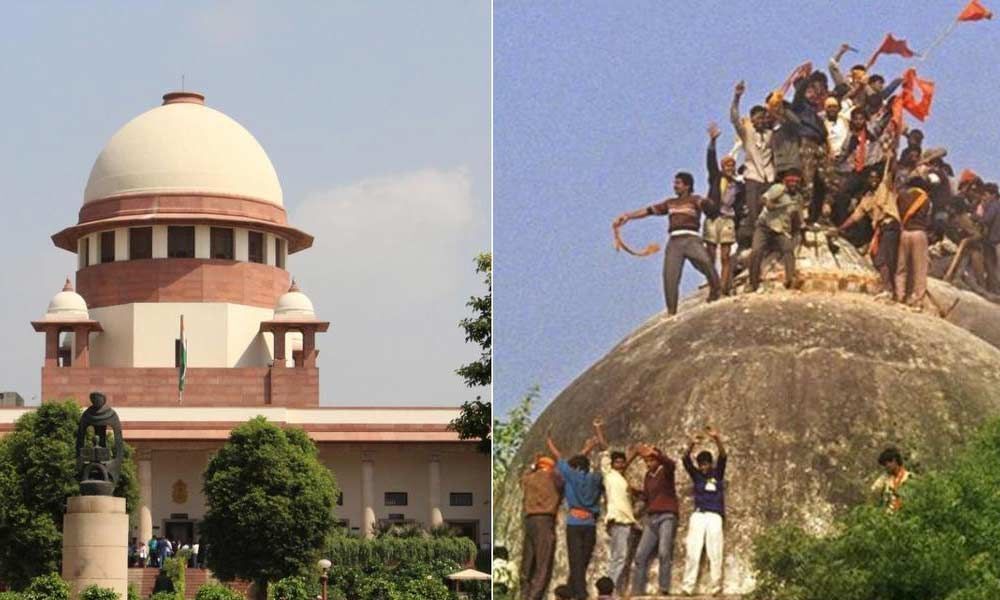Live
- Celta Vigo extend all-time club top-scorer Iago Aspas’ contract till 2026
- BGT: Kaif gives preference to Jaiswal-Rahul opening pair for Boxing Day Test against Australia
- Odisha CM Majhi, Naveen Patnaik extend Christmas greetings
- Icebreaker Keyboard: AluminIum Design Costing as Much as a MacBook Pro
- ‘Rifle Club’ Movie Review: A Stylish Thriller That Falls Short in Storytelling
- Chennai to Experience Heavy Rain as Severe Low-Pressure System Approaches Coastal Areas
- Pradeep’s ‘Akkada Ammayi Ikkada Abbayi’ hypes up with energetic new song
- Dil Raju releases ‘Adi Dha Saaru’ song from ‘Sahakutumbanam’
- GTA 5 Online Car Duplication Glitch: How to Duplicate Cars for Money (2024)
- 'Srikakulam Sherlock Holmes' Review: A quirky thriller thay doesn’t impress
Just In
Archaeological evidence after faith based arguments on Ayodhya


Last week, the Hindu parties argued in the Supreme Court on the credibility of the excavations by the Archaeological Survey of India (ASI) that have shown a massive public structure mainly used for worship existed at the disputed site in Ayodhya.
New Delhi: Last week, the Hindu parties argued in the Supreme Court on the credibility of the excavations by the Archaeological Survey of India (ASI) that have shown a massive public structure mainly used for worship existed at the disputed site in Ayodhya.
Initially the senior counsels representing the Ram Lalla Virajman, the deity, had contextualized the relevance of Hindu faith attached to the birthplace of Lord Ram at Ayodhya, and insisted that faith can be treated as credible evidence.
During last week, the counsels cited an ASI report which they referred to as "scientific evidence", to substantiate that a large number of cultural artefacts signifying different periods in history connected with the Hindu faith were found at the site where the Babri Masjid existed until it was razed in December 1992.
Although senior counsel C.S. Vaidyanathan, appearing for Ram Lalla Virajman, informed the court that there was nothing specific to show that the underground construction over which the Babri Masjid was built was a temple dedicated to Lord Ram.
But the assiduous Hindu faith and people's belief established that it was a temple dedicated to Lord Ram, they said.
The Constitution bench hearing the Ayodhya dispute had queried Vaidyanathan to prove the claim that a mosque was built on the ruins of the temple.
He told the court that archaeological evidence of a massive public structure indicated that people worshipped at the site and the images on the pillars further established that Hindus worshipped these images.
He cited the image of 'sheshnag' or snake god worshipped by Hindus.
This public structure, which probably dated back to 2nd century BC, was nearly 50x30 meters in dimension with many massive pillars, and the floor of the temple supported the pillars on square base.
No Muslim artefacts were found in the excavations, submitted the counsel.
During the excavations, a medieval 'nalla' usually used to drain out excess water or any other liquid was also discovered and it had a structure having a spout.
The counsel indicated towards the possibility of performing "abhishek" to god. This structure was circular and pointed towards the faith of the people.
According to the ASI report cited by the senior counsel, at the site of the Ram JanmaBhoomi, a massive wall of bricks was observed, which was identified as a fortification wall.
The counsel said that excavation material in the form of pottery, terracotta and other objects of the previous periods, particularly of Period I (Northern Black Polished Ware or NBPW level) and Period III (Kushan level) were found at the site.
The early medieval levels included the kushan and shunga levels, which date back to 3rd and 4th century BC. The NBPW probably went back to about 700 years before Christ.
Vaidyanathan produced before the court photographs of sculptures and images, found in the Babri Masjid structure -- before it was demolished by kar sevaks -- and argued that the place held divine sanctity for the Hindus.
He also cited images on the pillars showing a Garuda flanked by lions.
The ASI report of August 2003 was the fifth report on the historical topography of Ayodhya, a temple town in Faizabad district in Uttar Pradesh.
A.E. Cunningham, a British surveyor, conducted the first survey in Ayodhya in 1862-63 followed by another in 1889-91 by A. Fuhrer.
Professor A.K. Narain organised the third excavation in Ayodhya in 1969-70. Finally, Professor B.B. Lal conducted a more critical study of the area in 1975-76.
Vaidyanathan produced nearly 100 photographs of objects, which include several cultural artefacts, excavated from the disputed area to establish that the place was revered by Hindus for its divinity for many thousands of years.
He informed the court on the interpretation of these objects by archaeologists.
"The finding of the ASI report was based on the interpretation of excavated materials, which was recovered from the site, by archaeologists specializing in this field. Such interpretation should have been normally be accepted by the court," he said when queried that any human or animal figurines do not necessarily represents divinity.
He said that such imagery was not central to Islam, and do not find place on any structure inside the mosque.
The arguments will continue next week.

© 2024 Hyderabad Media House Limited/The Hans India. All rights reserved. Powered by hocalwire.com






